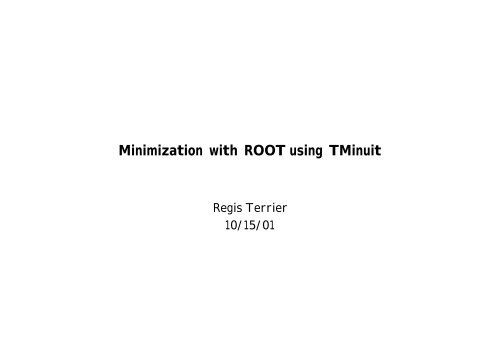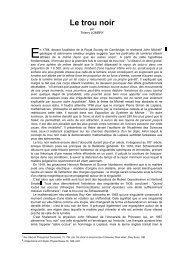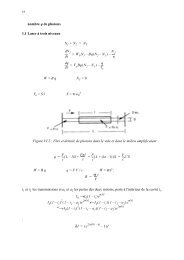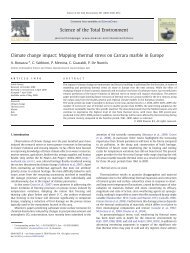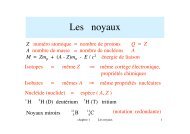Minimization with ROOT using TMinuit - GLAST at SLAC
Minimization with ROOT using TMinuit - GLAST at SLAC
Minimization with ROOT using TMinuit - GLAST at SLAC
You also want an ePaper? Increase the reach of your titles
YUMPU automatically turns print PDFs into web optimized ePapers that Google loves.
<strong>Minimiz<strong>at</strong>ion</strong> <strong>with</strong> <strong>ROOT</strong> <strong>using</strong> <strong>TMinuit</strong>Regis Terrier10/15/01
<strong>TMinuit</strong>• <strong>TMinuit</strong> inherits from Tobject• C++ transl<strong>at</strong>ion of F. James's Minuit package• See Document<strong>at</strong>ion <strong>at</strong>http://root.cern.ch/root/html/<strong>TMinuit</strong>.html• Can be used in a very close manner as initial package i.e.passing commands through a character string• C++ version independent of <strong>ROOT</strong> exists:Midnight package (in pdrApp)
FCN• <strong>TMinuit</strong> expects the function to minimize to beALWAYS a st<strong>at</strong>ic external function (no member functions).function pointer member of <strong>TMinuit</strong> is:void (*)(Int_t&npar, Double_t*gin, Double_t&f,Double_t*par, Int_t flag) fFCN• npar :number of free parameters involved in minimiz<strong>at</strong>ion• gin : computed gradient values (optional)• f : the function value itself• par : vector of constant and variable parameters• flag : to switch between several actions of FCN
FCN• The general FCN function:void FCN(Int_t&npar, Double_t*gin, Double_t&f, Double_t*par, Int_t flag){// select case <strong>using</strong> flagswitch(flag)case 1:// Initializ<strong>at</strong>ioncase 2:// Compute deriv<strong>at</strong>ives// store them in gincase 3:// after the fit is finishedelse:// compute function itselff= …}Most of the time just forget about flags (unless if you computethe gradient yourself)
Accessing d<strong>at</strong>a in FCNHow to access your d<strong>at</strong>a in FCN?• FCN is an external function so in order to access d<strong>at</strong>a usedfor comput<strong>at</strong>ion, you have 2 options:– <strong>using</strong> st<strong>at</strong>ic objects or variables.ex:TSkyMapList* unmodG;st<strong>at</strong>ic void fcn_nosource(int &npar, double *gin, double &f, double *par, intiflag){// compute likelihoodf=0;double p0=par[0];double p1=par[1];double norm = unmodG.Sum();}<strong>with</strong> an initializ<strong>at</strong>ion functionvoid Like::Init(TSkyMapList& modelG){unmodG = &modelG;...}
Accessing d<strong>at</strong>a in FCN<strong>using</strong> SetObjectFit(TObect*) and GetFitObject()- d<strong>at</strong>a must be in 1 TObject(does not exist in Midnight) ex:Tminuit* minuit=0;st<strong>at</strong>ic void fcn_nosource(int &npar, double *gin, double &f, double *par, intiflag){// compute likelihoodf=0;double p0=par[0];double p1=par[1];TSkyMapList* unmodG = (TSkyMapList*) minuit–>GetObjectFit();double norm = unmodG–>Sum();....}And in the general fitting function:void Like::Minimize(TSkyMapList& modelG){// Define Minuit for 3 parametersminuit = new <strong>TMinuit</strong>(3);minuit–>SetFitObject(&modelG);...}• All d<strong>at</strong>a must be stored in one TObject
Initialis<strong>at</strong>ion of minuitFirst cre<strong>at</strong>e minuit and define function to minimizevoid Like::Minimize(double* flux){// Init st<strong>at</strong>ic variables for the fit//Instanti<strong>at</strong>e Minuit for 2 parameters<strong>TMinuit</strong> minuit(2);// Set fonction pointerminuit.SetFCN(fcn_nosource);// Vector of step, initial min and max valuedouble vstrt[2];double stp[2];double bmin[2];double bmax[2];vstrt[0] = flux[0]; vstrt[1] = flux[1];stp[0]=0.01; stp[1]= 0.01;bmin[0] = vstrt[0]-1.; bmin[1] = vstrt[1]-1.;bmax[0] = vstrt[0]+1.; bmax[1] = vstrt[1]+1.;
Now define parameters <strong>using</strong>Initialis<strong>at</strong>ion (cont)void mnparm(Int_t k1, TString cnamj, Double_t uk, Double_t wk, Double_t a, Double_t b, Int_t &ierflg)double arglist[10];int ierflg = 0;minuit.mnparm(0, "Flux galactique", vstrt[0],stp[0],bmin[0],bmax[0],ierflg);minuit.mnparm(1, "Flux extragalactique",vstrt[1],stp[1],bmin[1],bmax[1],ierflg);Or use:Int_t DefineParameter( Int_t parNo, const char *name, Double_t initVal, Double_tinitErr, Double_t lowerLimit, Double_t upperLimit )Set ouput// Set Print Level// -1 no output// 1 standard outputminuit.SetPrintLevel(-1);// No Warningsminuit.mnexcm("SET NOW", arglist ,1,ierflg);
Defining str<strong>at</strong>egy// Set error Definition// 1 for Chi square// 0.5 for neg<strong>at</strong>ive log likelihoodminuit.SetErrorDef(0.5);<strong>Minimiz<strong>at</strong>ion</strong> str<strong>at</strong>egy// 1 standard// 2 try to improve minimum (slower)arglist[0]=2;minuit.mnexcm("SET STR",arglist,1,ierflg);Fixing and releasing parameters (beware the numbering):// fix galactic fluxarglist[0] = 1;minuit.mnexcm("FIX ", arglist ,1,ierflg);or (beware the numbering):minuit.FixParameter(0);
<strong>Minimiz<strong>at</strong>ion</strong> itselfCall Migrad <strong>with</strong> 500 iter<strong>at</strong>ions maximumThe MIGRAD algorithm is in general the best minimizer for nearly all functions. It is a variable-metricmethod <strong>with</strong> inexact line search, a stable metric upd<strong>at</strong>ing scheme, and checks for positivedefiniteness. Its main weakness is th<strong>at</strong> it depends heavily on knowledge of the first deriv<strong>at</strong>ives, andfails miserably if they are very inaccur<strong>at</strong>e.arglist[0] = 500;minuit.mnexcm("MIGRAD", arglist ,1,ierflg);Or:minuit.SetMaxIter<strong>at</strong>ion(500);minuit.Migrad();OutputFCN=26299.8 FROM MIGRAD STATUS=CONVERGED 49 CALLS 50 TOTALEDM=5.14224e-09 STRATEGY= 2 ERROR MATRIX ACCURATEEXT PARAMETER STEP FIRSTNO. NAME VALUE ERROR SIZE DERIVATIVE1 Flux galactique 1.02412e+00 6.04935e-02 2.94882e-03 -2.45383e-032 Flux extragalactique 9.93560e-01 4.44450e-02 2.16529e-03 -3.62470e-03Sometimes use Melder & Nelde Simplex methodminuit.mnsimp();
. .26950 ... . .. . .26900 ... * . .. . .26850 ... . .. . .26800 ... * . *.. .26750 ... . .. * . * .26700 ... . .. . * .26650 ... * . .. . * .26600 ... . * .. * . .26550 ... . * .. * . * .26500 ... . * .. * . .26450 ... . * .. * . * .26400 ... * . * .. * . * .26350 ... * . * * .. * . * .26300 ......................................*.*.*.&.*.*.*.*.................................. . .26250 ....................................................................................../ / / / / / / / /-0.025 0.225 0.475 0.725 0.975 1.225 1.475 1.725 1.975Scan is usefull to check FCNvari<strong>at</strong>ion over the selectedrangearglist[0] = 0;minuit.mnexcm("SCAN", arglist,1,ierflg);
Getting fit resultNow fill fitted variables E0,G0 and associ<strong>at</strong>ed errorsminuit.GetParameter(0,G0,errG0);minuit.GetParameter(1,E0,errE0);Get minimum log likelihooddouble ln0,edm,errdef;int nvpar,nparx,icst<strong>at</strong>;minuit.mnst<strong>at</strong>(ln0,edm,errdef,nvpar,nparx,icst<strong>at</strong>);Get 1 and 2 sigma contour//1 sigmaTgraph* graph1 =(TGraph*) minuit.Contour(10,0,1);// 2 sigmaminuit.SetErrorDef(2);Tgraph* graph2 =(TGraph*) minuit.Contour(10,0,1);
• Many more functionsAnd much moresee http://root.cern.ch/root/html/<strong>TMinuit</strong>.htmland http://wwwinfo.cern.ch/asdoc/minuit/minmain.htmlSee also in TH1.cxxvoid H1FitLikelihood(Int_t &npar, Double_t *gin, Double_t &f,Double_t *u, Int_t flag)In pdrApp, see CsIClustersAlg::Profile()


